Interesting Facts About Kazakhstan You Never Knew
Did you know Kazakhstan is the world's largest landlocked country? It's home to over 120 ethnic groups and boasts the longest continuous land border globally, sharing over 7,500 km with Russia. The country's name means "Land of Wanderers," reflecting its nomadic heritage. You'll find Lake Balkhash, a unique body of water with both fresh and saltwater sections. Kazakhstan also houses five UNESCO World Heritage Sites, including ancient rock carvings and Silk Road landmarks. Don't forget to try kumis, the national drink made from fermented mare's milk. There's much more to discover about this diverse Central Asian nation.
This post may contain affiliate links. If you make a purchase through these links, I may earn a commission at no additional cost to you. Additionally, portions of this post may be generated using artificial intelligence (AI) technology. While we strive for accuracy, please be aware that AI-generated content may not always be perfect and should be fact-checked when necessary.
The Spatula Scoops
- Kazakhstan is the world's largest landlocked country, covering an area of 2,724,900 square kilometers.
- The Kazakhstan-Russia border is the longest continuous land border globally, spanning over 7,500 kilometers.
- Lake Balkhash in Kazakhstan has two distinct ecosystems: one half is freshwater, the other half is saltwater.
- Kazakhstan's national drink, kumis, is made from fermented mare's milk and nicknamed "milk champagne."
- The country hosts five UNESCO World Heritage Sites, including the Petroglyphs of Tamgaly with over 5,000 Bronze Age rock carvings.
Longest Border in the World
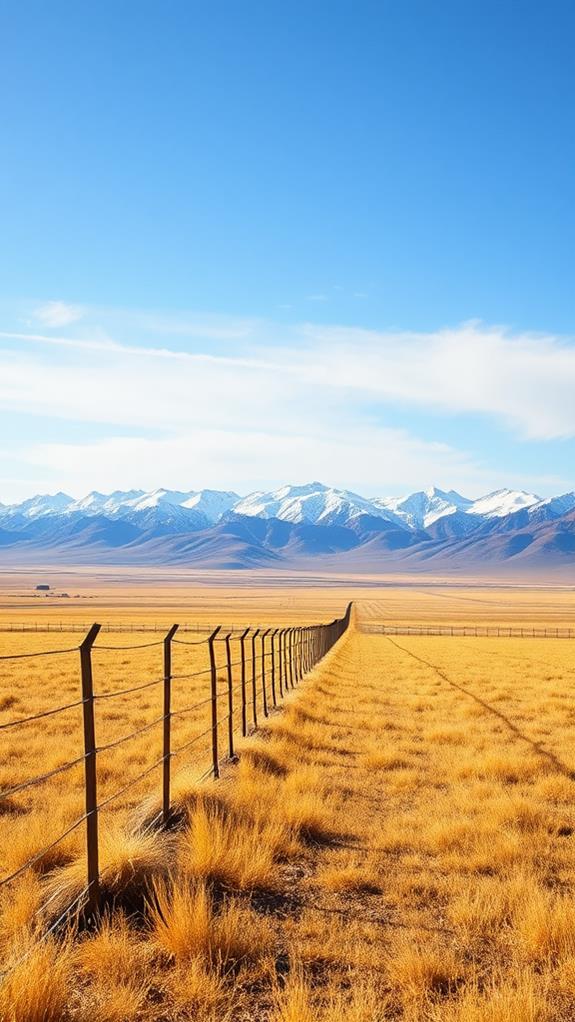
Stretching over 7,500 km, Kazakhstan's border with Russia holds the title for the longest continuous border in the world. This impressive boundary isn't just a line on a map; it's a reflection of the vastness of both countries. You might be surprised to learn that it's the second longest border overall, trailing only behind the Canada-US border.
This extensive frontier plays an essential role in shaping Kazakhstan's geopolitical landscape. It's not just about politics, though. The border greatly influences trade and cultural exchange between the two nations. As you'd imagine, such a long boundary creates numerous opportunities for cross-border interactions and economic activities.
What's fascinating is the diverse terrains this border spans. From sweeping steppes to rugged mountains and winding rivers, you'll find a rich tapestry of landscapes along its length. This geographic variety reflects Kazakhstan's own diverse topography.
Understanding this border's importance is key to grasping Kazakhstan's strategic position in Central Asia. It's a fundamental aspect of the country's identity and international relations, shaping its interactions not only with Russia but with the wider global community.
Ethnically Diverse Population

While many countries boast diverse populations, Kazakhstan stands out as a remarkable tapestry of ethnic groups. You'll find an impressive array of cultures within its borders, with around 120 different ethnicities calling Kazakhstan home. The Kazakh people make up the largest group, followed by Russians, Ukrainians, and Uzbeks. This diversity has led to a unique blend of languages and traditions, with both Kazakh and Russian serving as the primary languages spoken throughout the country.
Kazakhstan's commitment to multiculturalism promotes social cohesion, contributing to a distinctive national identity that combines various customs and practices. You might be surprised to learn that more than 20% of the population identifies as ethnic Russian, reflecting the country's historical ties and ongoing cultural influence. This interplay of different ethnicities has fostered a vibrant cultural heritage, which you can experience firsthand at annual festivals celebrating the traditions of various communities. As you explore Kazakhstan, you'll discover how this ethnic diversity has shaped the nation's culture, creating a rich and fascinating blend of traditions that sets it apart from its neighbors.
Largest Landlocked Country Globally
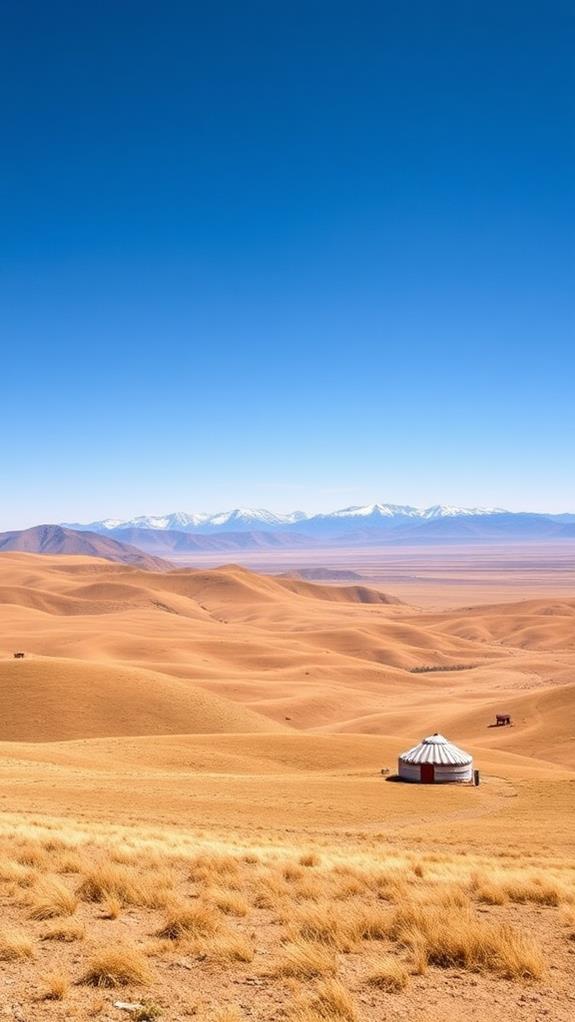
You might be surprised to learn that Kazakhstan holds the title of the world's largest landlocked country, covering an expansive area of 2,724,900 square kilometers. This unique geographic feature presents both challenges and opportunities for Kazakhstan's economy, particularly regarding trade routes and international commerce. Despite lacking direct ocean access, the country boasts the Caspian Sea along its western border, which serves as an essential waterway for transportation and resource exploitation.
Unique Geographic Features
Kazakhstan holds the title of the world's largest landlocked country, covering an impressive 2,724,900 square kilometers. This vast expanse boasts unique geographic features that'll leave you in awe. From the sweeping steppes to the rugged mountainous regions, Kazakhstan's landscape is as diverse as it is expansive.
You'll find Kazakhstan's border stretching an incredible 7,500 kilometers, making it the longest continuous border in the world. Much of this boundary is shared with Russia to the north. Despite being landlocked, you might be surprised to learn that Kazakhstan has a coastline along the Caspian Sea, the world's largest inland body of water.
| Feature | Description | Significance |
|---|---|---|
| Area | 2,724,900 sq km | 9th largest globally |
| Highest Point | Mount Khan-Tengri | 6,995 meters |
| Border Length | 7,500+ kilometers | Longest continuous |
| Climate | Continental | Extreme variations |
Kazakhstan's climate is as diverse as its terrain. You'll experience sharply continental weather patterns, with bitterly cold winters and scorching hot summers. This climatic variation contributes to the country's unique ecosystem and biodiversity, making it a fascinating destination for nature enthusiasts and geographers alike.
Economic Impact Assessment
As the world's largest landlocked country, Kazakhstan faces unique economic challenges and opportunities. Its lack of direct ocean access greatly impacts trade logistics, forcing the nation to rely heavily on rail and road connections for international commerce. This geographical constraint has prompted Kazakhstan to focus on:
- Expanding transportation networks
- Improving trade agreements with neighboring countries
- Developing strategic partnerships for efficient goods movement
Despite these challenges, Kazakhstan's economy thrives on its abundant natural resources. As a top producer of oil and uranium, the country has managed to sustain economic growth through mining and energy production. You'll find that Kazakhstan's mineral resources are incredibly diverse, with over 99 elemental minerals contributing to its economic stability.
However, the landlocked status complicates economic diversification efforts. To overcome this, Kazakhstan is actively working on enhancing its regional trading position. By improving its transportation infrastructure and fostering stronger relationships with land-bordering nations, the country aims to streamline its trade logistics and boost its economic potential. As you can see, Kazakhstan's unique geography shapes its economic landscape, presenting both hurdles and opportunities for growth.
Significance of Kazakhstan's Name
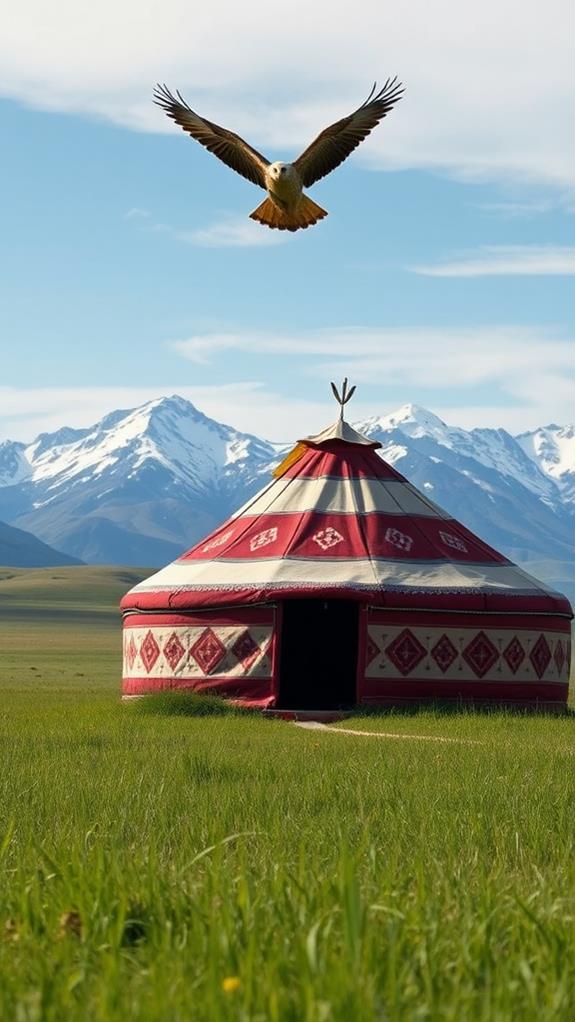
From its very name, you'll discover a rich tapestry of history and culture. "Kazakhstan" translates to "Land of Wanderers," perfectly capturing the nomadic heritage of its people. The term "Kazakh" itself means wanderer or independent, reflecting the country's deep-rooted connection to a life of mobility and self-sufficiency.
This name isn't just a label; it's a significant part of Kazakhstan's cultural identity. It emphasizes the values of independence and freedom that have been fundamental to Kazakh traditions for centuries. As you explore this vast Central Asian country, you'll encounter landscapes that echo the nomadic lifestyle of its ancestors.
Kazakhstan's name embodies the essence of its people's resilience and adaptability. These qualities have been essential throughout their history, allowing them to thrive in diverse environments. The name serves as a constant reminder of the country's unique heritage, blending ancient customs with modern progress.
Understanding the significance of Kazakhstan's name provides you with insight into the nation's character. It's a reflection of the enduring spirit of a people who've maintained their identity through centuries of change and challenge.
Home to Unique Lake Balkhash
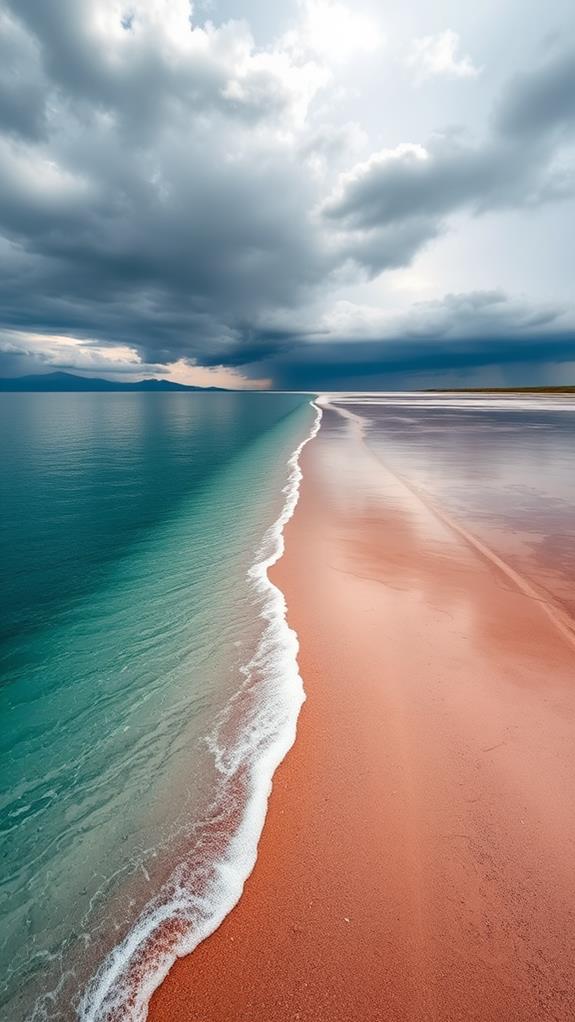
A shimmering jewel in the heart of Central Asia, Lake Balkhash stands out as one of Kazakhstan's most remarkable natural features. As the 15th largest lake in the world, it covers an impressive 16,400 square kilometers. But size isn't the only thing that makes Lake Balkhash unique. This massive water body is split into two distinct ecosystems:
- The western part contains freshwater
- The eastern part is filled with saltwater
- Both sections support diverse biodiversity
You'll find the Ili River feeding into Lake Balkhash, playing an essential role in maintaining its water balance and supporting its rich ecosystems. The lake's importance extends beyond its natural beauty, as it's a crucial resource for local fishing industries. Various fish species thrive here, contributing markedly to the regional economy.
However, Lake Balkhash faces environmental concerns that threaten its delicate balance. Water diversion and pollution are putting pressure on this unique ecosystem. As you learn about Kazakhstan's natural wonders, it's important to understand the challenges facing its water resources. Preserving Lake Balkhash's biodiversity and ensuring sustainable use of its resources is essential for both the environment and the local communities that depend on it.
UNESCO World Heritage Sites
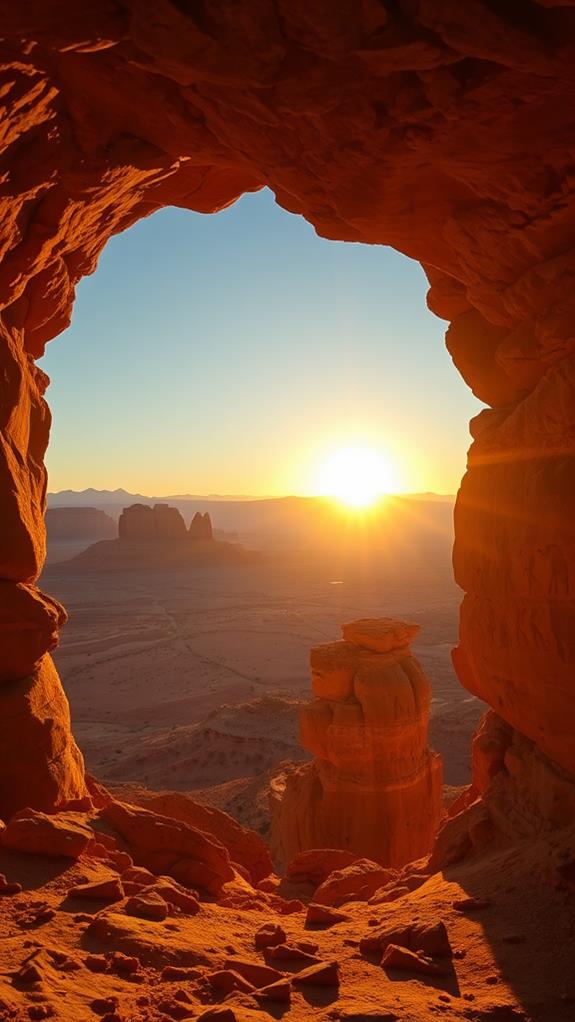
Within Kazakhstan's borders lie five UNESCO World Heritage Sites, each offering a unique glimpse into the country's rich cultural and natural heritage. You'll find a diverse array of sites that showcase Kazakhstan's historical significance and natural beauty.
One of the most fascinating sites is the Petroglyphs of Tamgaly, inscribed in 2004. Here, you can explore over 5,000 rock carvings dating back to the Bronze Age, depicting scenes of daily life from ancient times. Another remarkable site is the Mausoleum of Khoja Ahmed Yasawi, a 14th-century architectural marvel that serves as both a pilgrimage center and a symbol of Kazakhstan's cultural heritage.
If you're interested in natural wonders, don't miss Saryarka – Steppe and Lakes of Northern Kazakhstan. This vast area, designated in 2008, is home to important bird habitats and diverse ecosystems spanning extensive grasslands. It's a prime example of Kazakhstan's commitment to preserving its biodiversity.
The country's UNESCO sites also include ancient Silk Road routes, which played an essential role in facilitating the exchange of goods, traditions, and knowledge across the region. These cultural landscapes offer a tangible link to Kazakhstan's historical importance in global trade networks.
What Makes Kazakhstan’s Facts as Fascinating as Cambodia’s?
Kazakhstan’s vast steppes and modern cities blend history and innovation, making it as captivating as the rich heritage of Angkor Wat or the floating villages highlighted in facts about cambodia. Both nations offer unique glimpses into ancient cultures while embracing progress, showcasing a spellbinding mix of tradition and modernity.
Kumis: The National Drink

Throughout Kazakhstan, you'll find kumis, the national drink that's deeply woven into the country's cultural fabric. This traditional beverage, often called "milk champagne" due to its effervescence, is made from fermented mare's milk and holds a special place in Kazakh culture. Kumis isn't just a revitalizing drink; it's a reflection of Kazakhstan's nomadic heritage and the importance of horses in their society.
When you try kumis, you'll experience:
- A tangy, slightly alcoholic flavor profile
- A connection to centuries-old traditions
- A taste of Kazakhstan's equestrian culture
The fermentation process of kumis involves natural lactic acid bacteria and yeasts, resulting in a unique beverage with supposed medicinal properties. In fact, notable figures like Anton Chekhov have used kumis as a remedy for various ailments. You'll often see kumis served during special occasions and gatherings, highlighting its significance in Kazakh social customs.
As you explore Kazakhstan, you'll discover that kumis represents more than just a national drink. It's a symbol of the country's rich history, traditional practices, and the enduring influence of its nomadic past on modern Kazakh culture.
Frequently Asked Questions
What Are 5 Facts About Kazakhstan?
You'll be amazed by Kazakhstan's vastness, like an endless sea of land. Here are five facts: 1) It's the world's largest landlocked country, 2) It shares the longest continuous border with Russia, stretching over 7,500 km, 3) It's home to about 120 ethnic groups, 4) It's the world's leading uranium producer and a top oil exporter, 5) The Caspian Sea, Earth's largest inland body of water, forms part of its western coastline, impacting its ecology and economy.
What Is Unique in Kazakhstan?
You'll find Kazakhstan uniquely intriguing for several reasons. It's the world's largest landlocked country, boasting a diverse landscape. You'll encounter Lake Balkhash, an extraordinary half-freshwater, half-saltwater lake. The country's name, meaning "land of wanderers," reflects its rich nomadic heritage. You'll experience a melting pot of cultures, with over 120 ethnic groups coexisting. Kazakhstan also shares the world's longest continuous land border with Russia, stretching an impressive 7,500 kilometers, shaping its trade and cultural exchanges.
What Is Kazakhstan Most Known For?
You'll likely recognize Kazakhstan for its vast geographical features and geopolitical significance. It's known for having the world's longest continuous border with Russia, spanning over 7,500 kilometers. As the largest landlocked country, it's rich in natural resources, particularly uranium and oil. You'll find Kazakhstan's diverse ethnic makeup, with over 120 groups, contributes to its cultural richness. Its historical importance along the Silk Road and its modern role in global energy markets are also notable features.
What Is the Old Name of Kazakhstan?
You might be surprised to learn that Kazakhstan's capital has had several names throughout history. The old name you're likely referring to is "Aqmola," which was used before 1998. However, it's worth noting that even before that, the city was called "Tselinograd" during the Soviet era. The name changes reflect Kazakhstan's evolving political landscape. In 1998, it became "Astana," meaning "capital" in Kazakh. Briefly renamed "Nur-Sultan" in 2019, it reverted to "Astana" in 2022.





